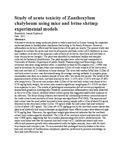| dc.description.abstract | Alternative medicine using medicinal plants is widely practiced in Kenya. Among the important medicinal plants is Zanthoxylum chalybeum that belong to the family Rutaceae. However, information on its toxic effects and the bioactivities of its parts are scanty. The present study was designed to evaluate the acute oral toxicity of aqueous root bark extract of Z chalybeum in mice and cytotoxic activities of the aqueous crude extracts of its leaves, stem bark and root bark in brine shrimp larvae (nauplii).
The plant was identified by traditional healers and samples collected for botanical identification.
The plant samples were collected and transported to University of Nairobi, Department of public Health, Pharmacology and Toxicology, where extraction was done using distilled water. A modified method of McLaughlin et al., (1998) was used to determine the median lethal concentrations (LCso) of crude extracts of the leaves stem bark and root bark of Z chalybeum to brine shrimps.
The acute oral median lethal dose (LDso) of root bark extract in mice was determined using the average moving methods. A complete gross examination was done on a random sample of mice after two weeks test period. The yields of the aqueous extracts of stem bark, root bark and leaves were 11.67% w/w, 22.01% w/w and 29.40% w/w respectively. The acute oral median dose (LDso) of the root bark extract was found to be> 6750 mg/kg body weight, the extract also caused a significant weight gain (P = 0.019) on short term exposure to mice.
The results of pathological examination did not reveal any significant lesions both grossly or histologically. However, mononuclear inflammatory cells were observed in the liver of the vehicle (destilled water) control group that suggested inadvertent exposure to an infection. The Brine shrimp lethality test showed the relationship between concentrations of the crude extracts and mortality of brine shrimps was significant (P<O.OOl). The aqueous root bark extract was the most potent toxicant to brine shrimp nauplii with a LCso of about 94 ug/ml, followed by the stem bark extract (LCso 770 ug/ml) while the leaf extract had least lethality (LCso of about 1305 ug/ml).
The LDso of> 6750 mg/kg given by the root bark extract shows that plant is of relatively low
toxicity because no significant toxic effects in mice were observed upto 6750 mg/kg dose. Moreover, the significant weight gain observed indicates that the root bark extract may contain appetite stimulants. The LCso of the root bark extract and stem bark extract was <1000 ug/ml, suggesting that they contain pharmacologically active phytochemicals. The major conclusion was that the aqueous root bark extract of Z. chalybeum caused mild toxic effects and promotes growth when administered orally to higher animals, hence safe for short term human and veterinary use. It's recommended that prolonged toxicity studies in the stem bark and root bark of Zanthoxylum chalybeum plants be performed to promote knowledge on their safe and efficacious use. | en_US |

